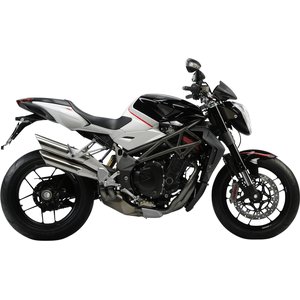MV Agusta Brutale 1090 (2010–2013): A Timeless Italian Masterpiece Revisited

Introduction
When MV Agusta unleashed the Brutale 1090 series in 2010, it wasn’t just launching a motorcycle—it was reaffirming Italy’s dominance in the art of blending raw power with sculpted elegance. Designed to dominate the hyper-naked segment, the Brutale 1090 generation (2010–2013) remains a benchmark for adrenaline-fueled craftsmanship. Having spent time with this machine, it’s clear why it’s still whispered about in garage conversations and trackday paddocks alike. This isn’t just a bike; it’s a declaration of passion. Let’s dissect why the Brutale 1090 continues to captivate riders over a decade later.
Design: Where Form Meets Aggression

The Brutale 1090 is a rolling sculpture. From its signature tubular steel trellis frame to the asymmetrical under-seat exhaust, every line screams Italian flair. The 2010–2013 models refined earlier design cues with sharper edges, LED lighting strips (on the RR), and monochromatic schemes that emphasized technical details like the radial-valve engine. The single-sided swingarm isn’t just functional—it’s a statement, exposing the rear wheel like a jewel in a showcase.
Key Design Upgrades:
- Integrated Lighting: Turn signals embedded into mirrors (1090R/RR) and LED taillights.
- Ergonomics: A redesigned one-piece seat improved comfort for both rider and passenger, though the 825–830 mm (32.5–32.7 in) seat height remains sporty.
- Materials: Forged aluminum wheels saved 1.5 kg (3.3 lbs) over previous models, enhancing agility.
Riding through city streets, the Brutale draws stares like a supercar. The metallic finishes on the engine casing and the minimalist tail section—pressure-cast in aluminum on the RR—reinforce its premium pedigree. This is a bike that refuses to blend in.
Engine Performance: Symphony of Chaos

At the heart of the Brutale 1090 lies a 1,078 cc inline-four engine with radial valves—a configuration still rare outside MotoGP. The base 1090 and R models deliver 144 hp (106 kW) at 10,300 rpm, while the RR variant cranks it up to 158 hp (116.5 kW) at 11,900 rpm, thanks to revised camshafts and a freer-breathing exhaust. Torque peaks at 115 Nm (84.8 lb-ft) on the R, but the RR prioritizes top-end scream with 100 Nm (73.8 lb-ft) at a stratospheric 10,100 rpm.
Riding Impressions:
- Low-End Manners: Surprisingly tractable below 5,000 rpm, making stoplight crawls manageable.
- Mid-Range Punch: From 6,000 rpm, the engine awakens with a linear surge, pulling hard to the 12,000 rpm redline.
- Soundtrack: The howl of the four-cylinder, channeled through twin under-seat pipes, is operatic—a mix of mechanical snarl and harmonic precision.
The 8-level traction control (a novelty in 2010) feels minimally intrusive, allowing controlled slides without muting the thrill. On a twisty backroad, short-shifting through the buttery 6-speed gearbox reveals a machine that’s as comfortable carving corners as it is devouring straights.
Handling: Precision Meets Playfulness
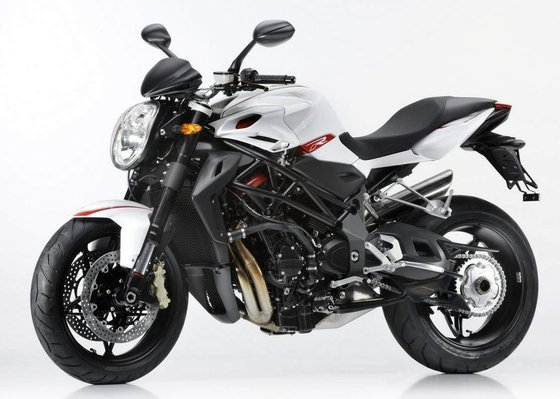
MV Agusta’s chassis philosophy shines here. The steel trellis frame and aluminum swingarm pivot plates strike a balance between rigidity and feedback. With a 1,438 mm (56.6 in) wheelbase and 25° rake, the Brutale flicks into corners eagerly yet remains stable at its 265 km/h (164.7 mph) top speed.
Suspension & Brakes:
- 1090/R: Marzocchi 50 mm USD forks (rebound/compression adjustable) and Sachs rear shock.
- 1090RR: Upgraded Öhlins NIX forks and Sachs shock with high/low-speed compression damping.
- Braking: Brembo radial monoblocs (320 mm discs on RR) offer surgical stopping power. The ABS version (post-2012) adds safety without dulling feel.
Riding the RR on a damp mountain pass, the Pirelli Angel ST tires (120/70-17 front, 190/55-17 rear) provided surprising grip, while the Sachs/Öhlins combo absorbed mid-corner bumps without unsettling the chassis. At 183 kg (403 lbs) dry (RR), it feels 50 kg lighter when leaned over.
Competition: How the Brutale Stacks Up

The Brutale 1090’s rivals were fierce, but none matched its charisma:
| Competitor | Key Differences | Brutale’s Edge |
|-----------------------|------------------------------------------------------|------------------------------------------------|
| Ducati Streetfighter S| 1,099 cc L-twin, 155 hp, steel trellis frame | Higher-revving engine, superior chassis feedback|
| Aprilia Tuono V4R | 1,077 cc V4, 167 hp, aggressive ergonomics | Lighter weight, more nuanced power delivery |
| Triumph Speed Triple | 1,050 cc triple, 131 hp, upright riding position | Italian design, exclusivity |
While the Streetfighter offered raw torque and the Tuono brute force, the Brutale carved its niche with a theatrical combination of aesthetics and high-RPM thrill. Its closest spiritual rival, the Ducati, couldn’t match its top-end frenzy, while the Triumph felt tame by comparison.
Maintenance: Keeping the Beast Alive
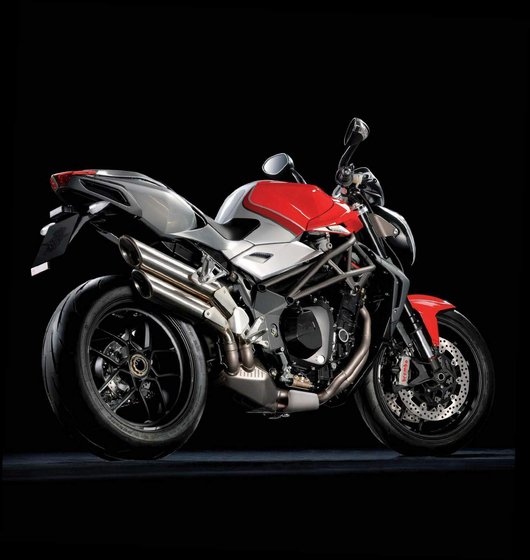
Owning a Brutale 1090 is a commitment to preserving art. Here’s what to prioritize:
- Engine Care:
- Use SAE 10W-60 fully synthetic oil (4.2 L with filter). The radial valve train demands frequent checks (every 5,000 km/3,100 mi).
-
Monitor coolant levels—the redesigned pump improves flow but watch for leaks.
-
Electronics:
-
The Magneti Marelli 5SM ECU can develop gremlins. A software update (available at MOTOPARTS.store) smooths throttle response.
-
Suspension:
-
Rebuild Marzocchi/Öhlins forks every 15,000 km (9,300 mi). Upgrade to Nitron shocks for track use.
-
Brakes:
-
Swap sintered pads (e.g., Brembo Z04) for sharper bite.
-
Aesthetic Upgrades:
- Carbon fiber kits (fenders, chain guards) shed weight and amplify the Brutale’s visual drama.
Pro Tip: The slipper clutch (RR models) requires periodic bleedings—don’t ignore sticky downshifts!
Conclusion: The Legacy Lives On
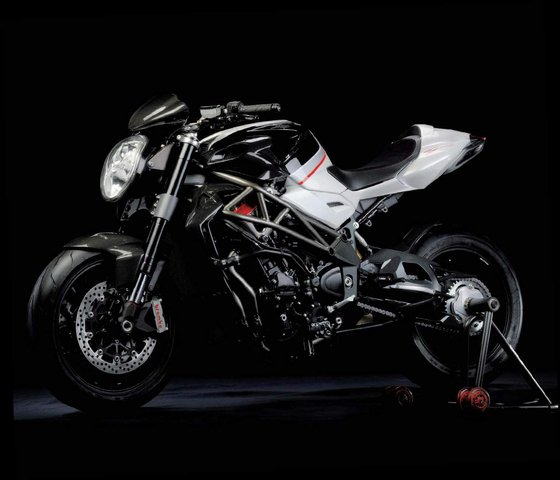
The MV Agusta Brutale 1090 isn’t just a motorcycle—it’s a mechanical muse. While newer nakeds boast more tech, none replicate its blend of artistry and aggression. Riding it today, the Brutale feels analog in a digital world: no ride modes, just a throttle cable connecting wrist to rear tire. It’s a bike that demands respect but rewards with unmatched exhilaration.
For owners, MOTOPARTS.store offers curated upgrades—from race-spec exhausts to bespoke levers—to keep your Brutale timeless. After all, why settle for ordinary when you can ride a masterpiece?
"Perfection is not an option." MV Agusta lived those words with the Brutale 1090. And perfection, it seems, never gets old.
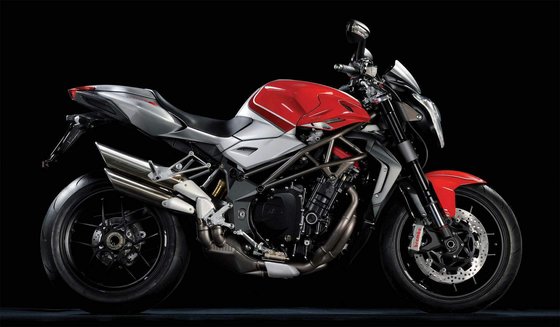





















Specifications sheet
| Engine | |
|---|---|
| Stroke: | Four-stroke |
| Max power: | 158 kW | 212.0 hp |
| Max torque: | 115 Nm |
| Fuel system: | Magneti Marelli IAW 5SM fuel injection with Mikuni throttle bodies |
| Max power @: | 11900 rpm |
| Displacement: | 1078 ccm |
| Max torque @: | 8000 rpm |
| Configuration: | Inline |
| Cooling system: | Liquid-cooled with separate oil and water radiators |
| Alternator output: | 350 W |
| Compression ratio: | 13.0:1 |
| Number of cylinders: | 4 |
| Valves per cylinder: | 4 |
| Dimensions | |
|---|---|
| Wheelbase: | 1438 mm (56.6 in) |
| Dry weight: | 183 |
| Wet weight: | 221 |
| Seat height: | 825 mm (32.5 in) |
| Overall width: | 780 mm (30.7 in) |
| Overall length: | 2100 mm (82.7 in) |
| Ground clearance: | 150 mm (5.9 in) |
| Fuel tank capacity: | 23 L (6.1 US gal) |
| Drivetrain | |
|---|---|
| Clutch: | Wet multi-disc with mechanical anti-surging device (slipper clutch on RR models) |
| Final drive: | chain |
| Gear ratios: | ['13/38', '16/34', '18/32', '20/30', '22/29', '19/23'] |
| Chain length: | 118 |
| Transmission: | 6-speed constant mesh |
| Rear sprocket: | 47 |
| Front sprocket: | 15 |
| Electrical | |
|---|---|
| Battery: | 12V 8.6Ah |
| Lighting: | LED position lights and taillight |
| Instrumentation: | Analog tachometer with dual LCD displays (gear indicator, traction control settings) |
| Maintenance | |
|---|---|
| Engine oil: | 10W60 |
| Brake fluid: | DOT 4 |
| Spark plugs: | NGK CR9EB or CR9EIX |
| Spark plug gap: | 0.7 |
| Coolant capacity: | 1.9 |
| Forks oil capacity: | 1.2 |
| Engine oil capacity: | 4.2 |
| Engine oil change interval: | Every 5000 km or 2 years |
| Valve clearance (intake, cold): | 0.10–0.20 mm |
| Valve clearance check interval: | 24,000 km / 15,000 mi |
| Valve clearance (exhaust, cold): | 0.20–0.30 mm |
| Recommended tire pressure (rear): | 2.5 bar (36 psi) solo, 2.8 bar (41 psi) with passenger |
| Recommended tire pressure (front): | 2.3 bar (33 psi) |
| Special Features | |
|---|---|
| ABS: | Available on select models |
| Exhaust system: | Titanium under-seat dual exhaust (Arrow system on Cannonball edition) |
| Traction control: | 8-level adjustable |
| Frame adjustments: | Adjustable steering head for geometry customization |
| Chassis and Suspension | |
|---|---|
| Frame: | CrMo steel tubular trellis with aluminum swingarm pivot plates |
| Rear tire: | 190/55 z-17 |
| Front tire: | 120/70 z-17 |
| Rear brakes: | Single 210mm disc with 4-piston caliper |
| Front brakes: | Dual 320mm floating discs with Brembo radial 4-piston calipers (ABS available) |
| Rear suspension: | Sachs progressive monoshock, adjustable rebound/compression damping and preload |
| Front suspension: | 50mm Marzocchi USD forks, adjustable rebound/compression damping and preload (Öhlins NIX on RR models) |
| Rear wheel travel: | 120 mm (4.7 in) |
| Front wheel travel: | 125 mm (4.9 in) |



